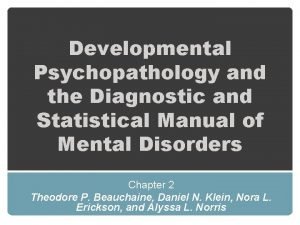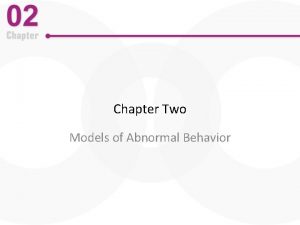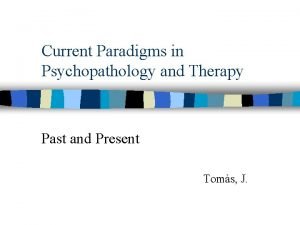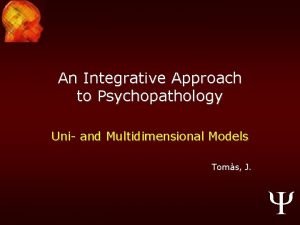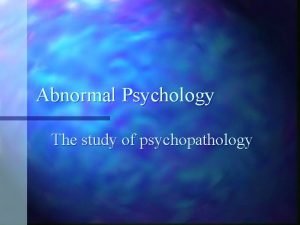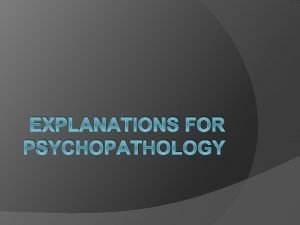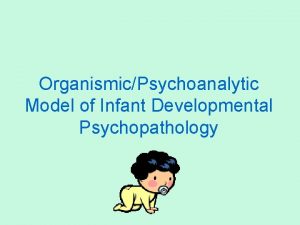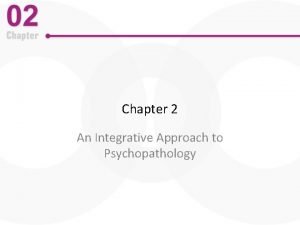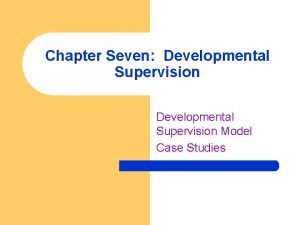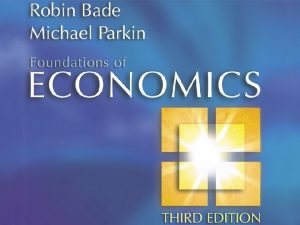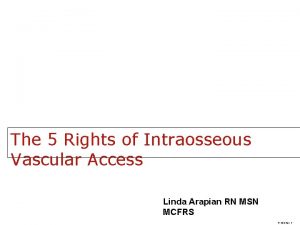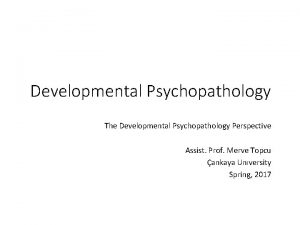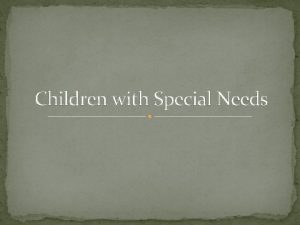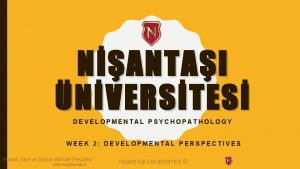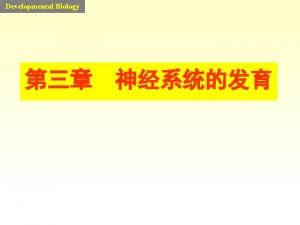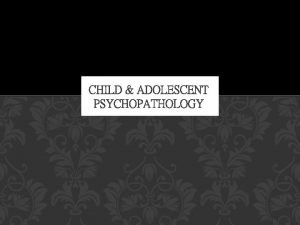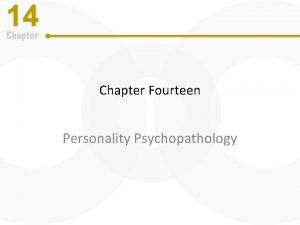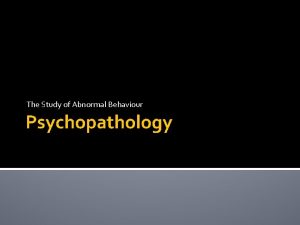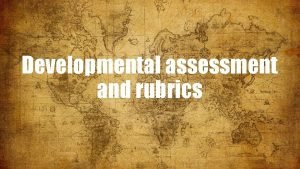OrganismicPsychoanalytic Model of Infant Developmental Psychopathology Psychopathology starts














- Slides: 14

Organismic/Psychoanalytic Model of Infant Developmental Psychopathology

• Psychopathology starts with the infant and develops through the influences – Biological/neurophysiological maturation – Accidental experiences with caregivers • Inner forces struggling for gratification – Sexual drives (Freud) – Aggressive drives (Klein) • Opposing forces that prevent immediate gratification – Censorship (disgust, shame, morality)—later, superego – Environment (reality)

• Conflicts create anxiety, which produces defense mechanisms and symptoms • Symptoms in adults and children (e. g. , transference, thumb-sucking) reflect earlier, more primitive conflicts from infancy • Caregivers affect development of symptoms in indirect, oblique ways, mediated by the meaning attached to it by the infant of young child

Infantile Sexuality S. Freud

• Infants experience sexual pleasure through sucking – Discovered by observing older children and adults and inferring unconscious recollection of an earlier pleasure – Desired from and auto-erotic phase of development in which pleasure was sought from one’s own body • Sexual pleasure is mediated through erotogenic zones – Oral – Anal – Phallic

• Toddlerhood—pleasure through anality – Release of stool brings pleasure – Withholding of stool brings pleasure – Constitute toddler’s first gift or attack • Early childhood—pleasure through masturbation • Sources of reappearance of sexual activity in childhood – “internal causes”—sexual constitution and development – “external contingences”—seduction – Aptitude for sexual irregularities is innately present

• Castration complex and penis envy—arising from children’s sexual research – Girls learn they are looking and want what boys have – Boys conclude that girls were castrated, and they are next on the chopping block • Perceptions of parental intercourse • Symptoms often emerge with re-emergence of sexual wishes – Transportation produces rocking which reminds one of infantile sexuality—repression changes perception of experience – Paralysis of an arm—previously used for masturbation – “Different separating normal from abnormal can lie only in relative strength of indirect components of the sexual instinct and in the use to which they are put in the course of development” (p. 205)

Infantile Aggression Klein

• Death instinct—aggression impulses—produces annihilation anxiety and then persecutory anxiety • Object attacked and destroyed, but then fear of retaliation (e. g. , Stewie on Family Guy) • Real external experiences reinforce these perceptions • Object also loved and idealized • Splitting into good—idealized—breast to protect against bad—dangerous and persecuting— breast • Klein called this stage “paranoid-subizoid position” (0 -4 months)

• Primitive relations—intend and extend—created by projection and introjection • Growing capacity for integration and synthesis produces the second stage, “depressive position” (4 -6 months) • Aggression has been directed all along against loved person (good breast = bad breast) • Anxiety and guilt of depressive position add powerful impetus toward beginning of Oedipal complex • Transference reveals irrationality of earliest object— relations (“the patient is bound to deal with conflicts and anxieties re-experienced towards the analyst by the same method he used in the past [in infancy]” (p. 55))

Infantile Feeding Disturbances A. Freud

• Three ways feeding becomes open to disturbance – Organic feeding disturbance – Nonorganic disturbance of instinctive process (↓ intensity of wishes) – Sexualization or aggressivization of function of feeding • Organic feeding disturbances—severe physical weakness, exhaustion, strain, convalescence • Disturbance of the Instinctive Process – Feeding schedules can diminish urge to eat – Restricting choice can diminish urge to eat

• Neurotic Feeding Disturbances – Eating related to stages of object love • Auto-erotism and narcissism • Object love • Altruistic love – Disturbances produced by ambivalent feelings toward mother (“mothers, though they do not produce these feeding difficulties in their children, nevertheless may behave in a manner which aggravates the pathogenic elements in the situation” (p. 126)) – Eating and oral pleasures—sucking can interfere with feeding

• Eating and anal pleasure—restricting play with food can interfere with feeding • Eating and aggression—eating inhibitions, refusal to bite, chew, or swallow food (oral sadism and resultant guilt and anorexia) • Eating and phallic pleasure—fear of oral impregnation or carrying a child, fear of growing up and sexually competing with parent of same sex, penis envy and wanting to bite off penis
 Developmental psychopathology approach
Developmental psychopathology approach One dimensional model psychology
One dimensional model psychology Current paradigms in psychopathology
Current paradigms in psychopathology Multidimensional integrative approach to psychopathology
Multidimensional integrative approach to psychopathology What is psychopathology
What is psychopathology Bacteria causing syphilis
Bacteria causing syphilis Language production
Language production Psychopathology
Psychopathology Multidimensional approach to psychopathology
Multidimensional approach to psychopathology Carl glickman
Carl glickman Developmental supervision model glickman
Developmental supervision model glickman Hart plain infant school
Hart plain infant school The webinar will begin shortly
The webinar will begin shortly The infant industry argument
The infant industry argument Intraosseous meaning
Intraosseous meaning
